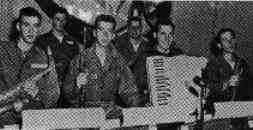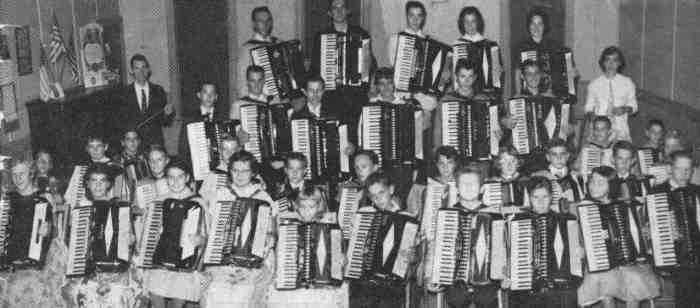A lifelong resident of Camden, N.J., Stanley Darrow was
reared in a music-loving family, but never really concentrated on
music-making until 16. At which time he became most seriously engaged in
accordion study. At 18 he moved to New York City to study music at the
N.Y. City College, followed by teacher training under Luis Appareti. This
latter activity developed into Stan teaching at the Acme Accordion Studio
of Brooklyn. He soon thereafter, assumed ownership of this school
On one of his visits home to Camden, Stanley met Sherrie Reisser. Shortly
thereafter they decided to go into partnership, and open the Acme Studio
in her home town, Westmont. As Westmont developed he had to make an
important decision . . . (i.e.) Westmont or Brooklyn? He couldn't handle
both adequately -- and has never regretted concentrating in the Westmont
area (just outside of Camden).
 In 1953, he was inducted into the Army for his two-year hitch (and
lifelong hitch to Sherrie). She carried on the business adequately during
this period while he devoted all his time during Army to music. The
highlight was being the leader of the popular 74th Army Band Combo (as
shown herewith) for a year. Then he was transferred to the Fort Dix Army
Band until his discharge. Broadcasting and entertaining was the order of
the day (and nights). A year after resuming his own studio activities, he
was able to open another accordion studio in Pitman, a nearby community --
in which Charles Brown, a former student of his, is in charge.
In 1953, he was inducted into the Army for his two-year hitch (and
lifelong hitch to Sherrie). She carried on the business adequately during
this period while he devoted all his time during Army to music. The
highlight was being the leader of the popular 74th Army Band Combo (as
shown herewith) for a year. Then he was transferred to the Fort Dix Army
Band until his discharge. Broadcasting and entertaining was the order of
the day (and nights). A year after resuming his own studio activities, he
was able to open another accordion studio in Pitman, a nearby community --
in which Charles Brown, a former student of his, is in charge.
Another active member of the staff is Mrs. Lorna Miller (graduate of Combs
College of Music with a BM degree in accordion) who has full charge of the
Intermediate and Junior Bands. The school has a complete curriculum from
Beginner's Course to Senior Teacher's Course. They are now in the process
of being approved by the New Jersey State Department of Education.
A most important phase of teaching activities, has been the rapid
development of band work -- with several groups gradually building up
experienced players. They have emerged as the Titano Accordion Symphony,
(shown on the front cover of this issue) of which Roman Pawlowski is the
concert master. Roman placed seventh Senior C of the recent AAA contest in
Chicago. The members are: Katy Kofoet, Joan Bruno, Kathy stone, Dennis
Ciccotelli, Charles Brown, Frank Hodnicki, Virginia Kreszswick, Lester
Hullings, George Borrelli, Roman Pawlowski, Bob Rozan, Nick Bubbico,
Louise Rodgers, Judy White and Pam Sobeck.

The Symphony's repertoire includes the two Mozart Serenades, Capriccio
Italien of Tschaikowsky, Bolero Boogie and many numbers in a lighter vein,
also. So popular has this group become, that they were engaged by the
American Legion to give eight outdoor summer concerts in Westmont -- with
scores of other appearances throughout the area for PTA's, Legion,
Churches, etc. Many fine soloists are being developed as a result of these
numerous public appearances. Six formal concerts have been presented --
with Andy Arcari, Anthony Galla-Rini, and Charles Magnante being featured
as guest artists in three of these events.
Stanley is firmly convinced that substantial progress for his students
cannot be achieved without constant entry into contests throughout a wide
area. In fact, this does not apply to the students alone -- what's good
for them he feels is doubly applicable for himself, for he is constantly
studying and practicing. He has had advanced coaching from A. Arcari and
J. Neupauer. He intends to reduce his regular schedule and concentrate
more on advanced teaching so more time can be devoted to composing and
building a repertoire for a concert career. He is attending Combs College
of music where he is working for a music degree as an accordion major. He
is on the Board of Governors for the Arcari Foundation and they are now in
the process of opening another accordion studio in Merchantville.
Stanley Darrow and his teaching staff have chosen the Titano Accordion,
for they feel it is the finest in the field and enables the students to
advance correctly. How can he be other than a "winner' in our field when
he couples intensive studies for himself, with a similar program scheduled
for his own advanced and serious students?
Special thanks to Darrin J. Krug http://hometown.aol.com/yolyanddarrin/index.html for
scanning photographs.

 In 1953, he was inducted into the Army for his two-year hitch (and
lifelong hitch to Sherrie). She carried on the business adequately during
this period while he devoted all his time during Army to music. The
highlight was being the leader of the popular 74th Army Band Combo (as
shown herewith) for a year. Then he was transferred to the Fort Dix Army
Band until his discharge. Broadcasting and entertaining was the order of
the day (and nights). A year after resuming his own studio activities, he
was able to open another accordion studio in Pitman, a nearby community --
in which Charles Brown, a former student of his, is in charge.
In 1953, he was inducted into the Army for his two-year hitch (and
lifelong hitch to Sherrie). She carried on the business adequately during
this period while he devoted all his time during Army to music. The
highlight was being the leader of the popular 74th Army Band Combo (as
shown herewith) for a year. Then he was transferred to the Fort Dix Army
Band until his discharge. Broadcasting and entertaining was the order of
the day (and nights). A year after resuming his own studio activities, he
was able to open another accordion studio in Pitman, a nearby community --
in which Charles Brown, a former student of his, is in charge.